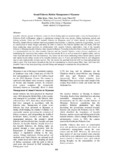| dc.description.abstract | The development of artificial reefs (ARs) in Southeast Asia reflects a range of motivations and approaches, from fisheries management to coastal protection and coral reef restoration. Such development is in line with the Plan of Action on Sustainable Fisheries for Food Security for the ASEAN Region Towards 2030, specifically “Plan of Action No. 35. Promote resource enhancement approaches with appropriate monitoring and evaluation programs, e.g. deployment of appropriate resource enhancement structures, restocking of commercially-important aquatic species, and restoration of degraded habitats, taking into consideration possible socio-ecological impacts.”
While not without challenges, ARs have demonstrated their potential as a tool for marine conservation and sustainable development in the region. Since 2006, the Marine Fishery Resources Development and Management Department (MFRDMD) of SEAFDEC, in collaboration with the Department of Fisheries of Malaysia (DOFM), has been actively engaged in a research and development program on ARs. Over the years, the long-term research activities yielded valuable oceanographic information for the advancement of AR design and construction techniques, which have been effectively utilized in the Malaysia Artificial Reefs National Program since 2006. Besides, research findings were crucial for the DOFM to innovate and implement new technologies, leading to continuous improvements in the effectiveness of the ARs program. This has significantly enhanced marine habitats and fishery resources across Malaysia. Furthermore, the information obtained was also shared by MFRDMD during the conduct of several initiatives and activities in the region including the conduct of a series of regional workshops on ARs since 2004, publication of “A Guide to Make and Set Durable Artificial Reef Fish Aggregating Devices (ARFADs) for Coastal Waters” in 2004, and publication of research paper “Protecting Coastal Habitats and Enhancing Fisheries Resources Using Big Size Artificial Reefs in the East Coast of Peninsular Malaysia” in 2013. | en |




